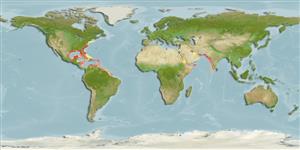Dulichiella appendiculata (Say, 1818)
| Native range | All suitable habitat | Point map | Year 2050 |

|
| This map was computer-generated and has not yet been reviewed. |
| Dulichiella appendiculata AquaMaps Data sources: GBIF OBIS |
Google image |
No photo available for this species.
Classification / Names Common names | Synonyms | CoL | ITIS | WoRMS
Malacostraca | Amphipoda | Melitidae
Environment: milieu / climate zone / depth range / distribution range Ecology
Benthic; depth range 0 - 148 m (Ref. 108023). Temperate
Distribution Countries | FAO areas | Ecosystems | Occurrences | Introductions
Western Indian Ocean and Western Atlantic: United Arab Emirates and USA.
Length at first maturity / Size / Weight / Age
Maturity: Lm ? range ? - ? cm Max length : 1.0 cm TL male/unsexed; (Ref. 118456); 1.11 cm TL (female)
Life cycle and mating behavior Maturity | Reproduction | Spawning | Eggs | Fecundity | Larvae
Main reference
References | Coordinator | Collaborators
Lowry, J.K. and R.T. Springthorpe 2007 A revision of the tropical/temperate amphipod genus Dulichiella Stout, 1912, and the description of a new Atlantic genus Verdeia gen. nov. Zootaxa 1424:1-62. (Ref. 75042)
IUCN Red List Status
(Ref. 130435: Version 2025-1)
CITES status (Ref. 108899)
CMS (Ref. 116361)
Threat to humans
Human uses
| FishSource |
Tools
More information
Max. ages / sizes
Length-weight rel.
Length-length rel.
Length-frequencies
Mass conversion
Abundance
Internet sources
BHL | BOLD Systems | CISTI | DiscoverLife | FAO(Publication : search) | Fishipedia | GenBank (genome, nucleotide) | GloBI | Gomexsi | Google Books | Google Scholar | Google | PubMed | Tree of Life | Wikipedia (Go, Search) | Zoological Record


